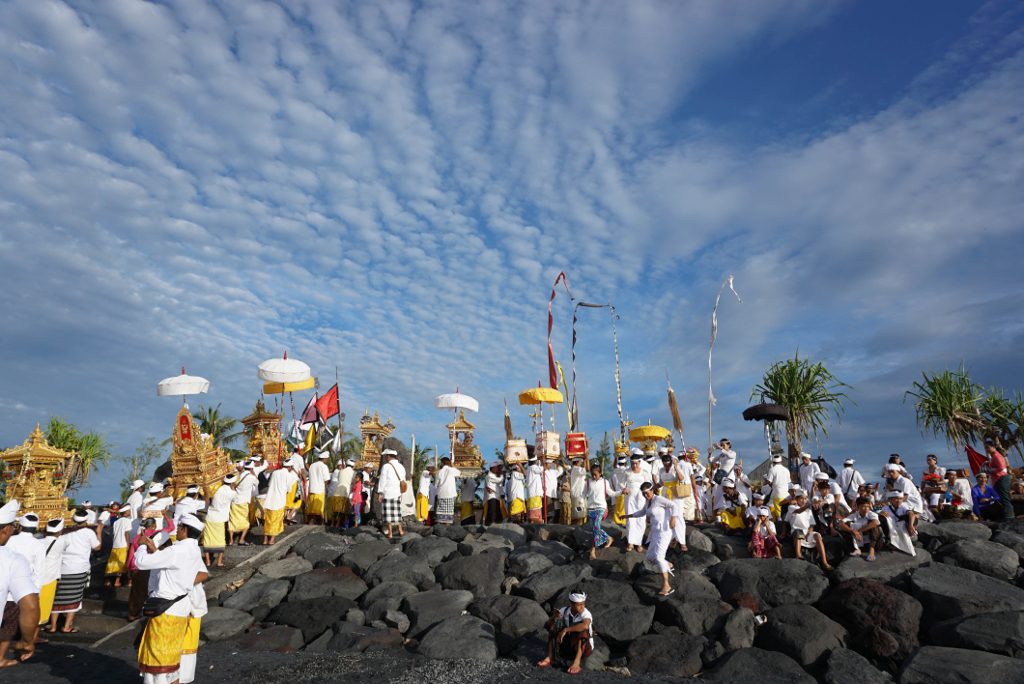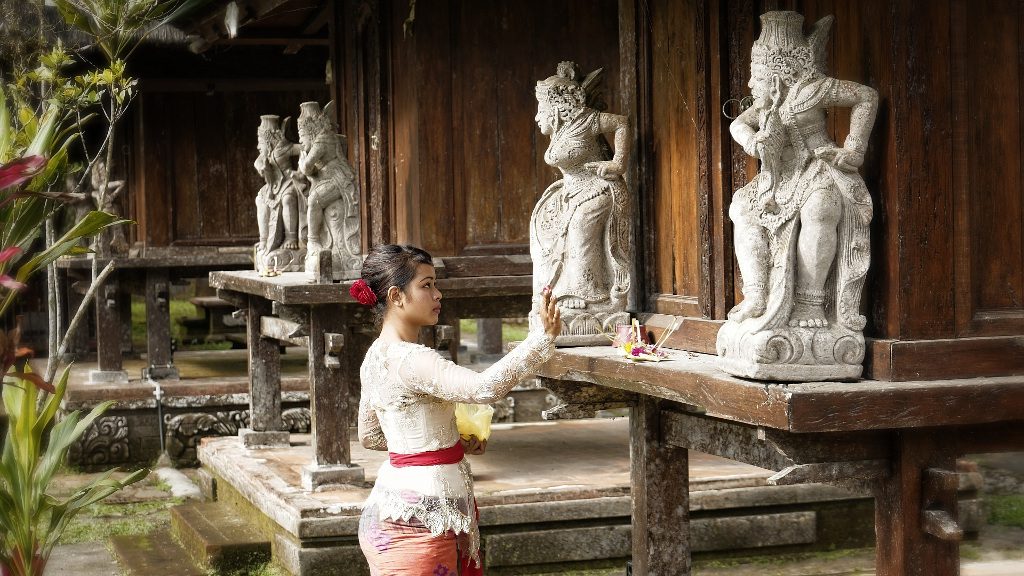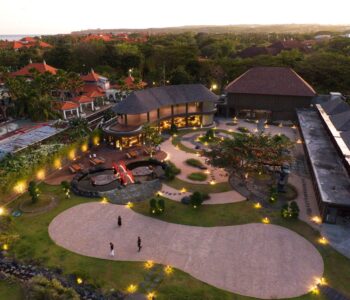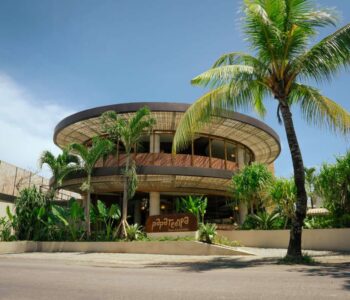The Balinese – and other Indonesian – culture(s) managed to achieve a high level of sophistication without any excessive pressure upon the balance of Mother Nature.

I am sure all of you, all readers, love bananas. They are ubiquitous in Bali. On roadsides, in back gardens, but weirdly enough, not in plantations. Why? Very simply because in the times of yore, before you came to Bali, the banana had to be ready anytime. But it was not only the fruit people were after, but the leaves. They could be used to wrap food, or as a plate; or better, when it rained, it was a perfect umbrella. And, as we say now, they were perfectly biodegradable.
As was nearly everything else in fact. No concrete was ever used, but clay bricks. Roofs were of alang-alang thatch or clay tiles. Roof beams of the highly sophisticated carpentry were joined without using a single metallic nail. As a matter of fact, iron, all important, was a rare and expensive material. And there was bamboo of course, which could be turned into a house, food, a spear or nearly any cooking instrument.
All in all, Balinese – and other Nusantarian- culture(s) managed to achieve a high level of sophistication without any excessive pressure upon the balance of Mother Nature. Of course the Balinese have in the past interfered with Nature. But, before modern times, they have done so beautifully: they have carved landscapes into rice fields, they have built biodegradable temples in the middle of the forest. They have made Nature a partner in their search of a Balinese beauty.
The pantheistic character of Balinese religion has, to a certain extent, contributed until recently to the preservation of the island’s nature. Trees are living beings. They may be endowed with only one single life principle (ekapramana), compared to animals, which have two such principles –(dwipramana), and human beings, who have three (tripamana). But they all the same must be treated properly. Thus big trees are dressed: one wraps a sarong around their trunk as a sign that they are living beings. Some are even provided with a nearby shrine, through which their “dweller spirit” (duwe) of the tree is addressed offerings by passers-by. For these reasons, one may not cut a tree without proper ritual precautions. After cutting the trunk, woodcutters never miss inserting a small branch on the stump and address it a small offering (pejati), complete with the proper prayer. “O, Lord”, they will say ,” Don’t show your anger to me for having made you fall. Accept instead my offering as your reward’’. And for each tree they fell, they will plant a sapling nearby, with another offering.
In fact, all aspects of nature are sacred, and all have their protective deity. The earth is the Mother goddess, Pertiwi. Fertilized through the entreaties of the god of water, Wisnu. Their union begot the demonic Bhoma, protector of vegetation. The mythical protector of Balinese villages, the Barong, is actually known as the Lord of the Forest, and its opponent, Rangda the witch, acquire her magical powers through the intercession of the cemetery’s huge kepuh trees. This reminds us that Man’s clearing of the forest is a relatively recent phenomenon. Until the 19th century, when the population was one third or one fourth of what it is now, villages were still often separated from one another by big expanses of forest.
Living in close symbiosis with nature, the Balinese have organized their environment in accordance with principles that reflect their awareness to remain in harmony with the larger cosmic order or Bhwana Agung. Thus they organize their occupation of land and architecture following two axis of pure-impure: mountain/sea (kaja/kelod) on the one side, corresponding respectively to the place of origin of irrigation water and the other the receptacle of used water; and East/West (kangin/kauh) on the other side, corresponding respectively to the rising and the setting sun. Thus the household temple (mrajan) is always situated kaja-kangin, the purest corner of the compound, and the cemetery is also situated in the kelod part of the village, on the side of the used waters. Similarly they establish and build villages, temples, buildings, the island of Bali and Man himself– as duplicates of the tripartite structure of the world: the Bhur (demonic), Bhwa (middle/human) , Swah (godly). Thus the lay-out of temples comprises three successive yards running along the axis of relative purity. The outer, “kelod” yard, called jaba , belongs to the “profane”; the middle (jaba tengah) is reserved to human-level activities; while the “inner” yard (jeroan) is where the gods reside, with the seat of Atintia (or Siwa, God) occupying the purest kaja-kangin spot.
While traditional Bali was effectively a setting in which virtually everything was biodegradable –hence the paucity of archaeological remains—and in which Man, with its villages and rice fields, was harmoniously inserted in the island’s lush nature, things have drastically changed in the last forty years. Not only has population grown from 2 to 3.5 million, but it has urbanized at a fast rate and moved en masse to the Southern part of the island. The greater Denpasar, which had a population of 150 thousand in 1970, has around one million now. Today’s population do not concentrate any more on high grounds close to rice fields, but increasingly along the roads, with a drastic impact on the beauty of the island – rice terraces are more often than not, occulted by shoddy buildings or overly imposing art shops. As for the banana leaves, they have disappeared, replaced by plastic clogging the rivers and littering the beaches.
Against such development, what is – sadly – interesting is that instead of facing reality and taking necessary steps, most Balinese, apart from largely impotent NGOs, prefer invoking the past. They have come up with what they call a set of “Balinese Philosophical Principles”, the Tri Hita Karana, which emphasizes harmony between the Man or the social principle (Pawongan), Nature (Palemahan) and the godly principle (Pahyangan). Tri Hita Karana has become a favourite mantra for local officials and public intellectuals. They constantly invoke harmony as being a given feature of Bali, as if it were an a-historical birthright of the island.
This ignores a few things: first Tri Hita Karana is, like many other things, an invented tradition. Probably dug from some obscure manuscript (no one knows which one), it was brought to the fore in the late 1960s by a well-known intellectual of the days, the late Gusti Ketut Kaler. It played a function for a time: modern Balinese architectural norms were defined in accordance with its principles. Alas, they were mainly enforced when it came to government buildings or foreign investments. It was never applied to urban planning or to ordinary architecture.

Those two combined phenomenons –deterioration of the environment and Tri Hita Karana craze—underline the impotency of modern Balinese to face reality, i.e. to take concrete steps to protect their environment. Battered by modernity and globalization, flattered by all quarters because of the reputation of their culture, today’s Balinese seem to refuse to face the challenges of their future, they prefer to withdraw into an idealized past, that of a tradition of their dreams. That of passivity.
In an island long characterized by the fact that ‘all’ its inhabitants were active participants of its arts and culture, it is a sad development indeed. It explains why people prefer to wrap food in plastic rather than banana leaves.
No surprise if mother earth is rumbling.









